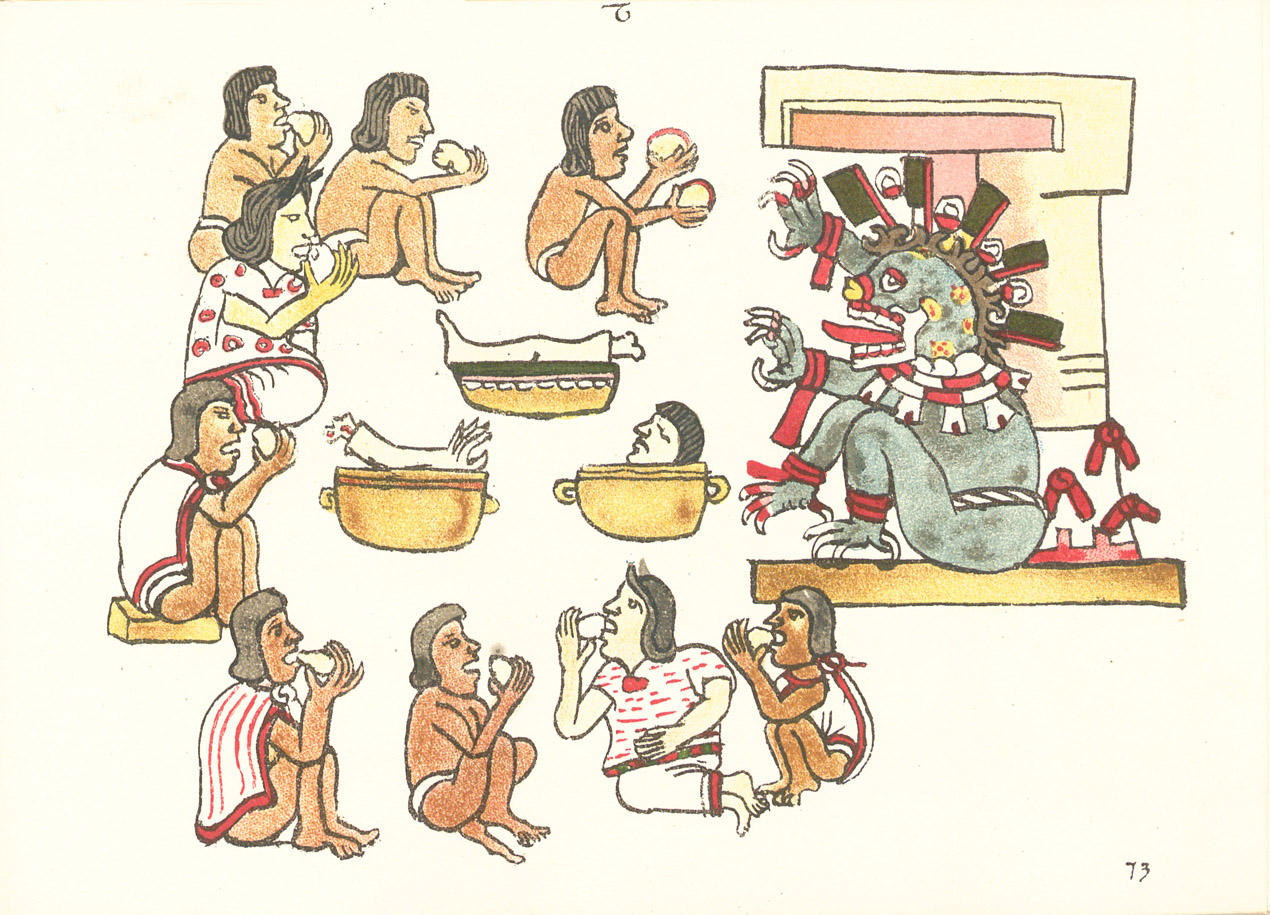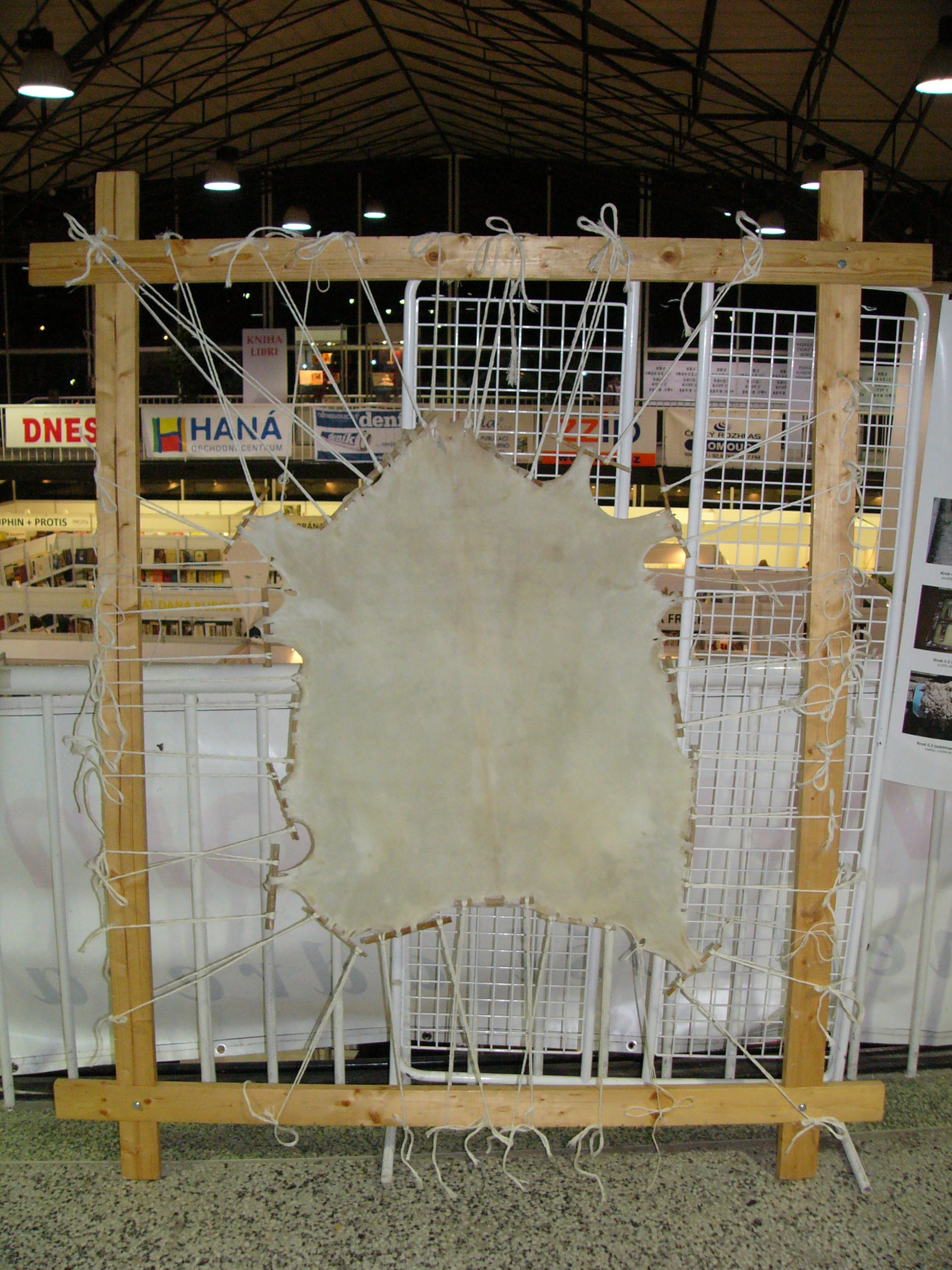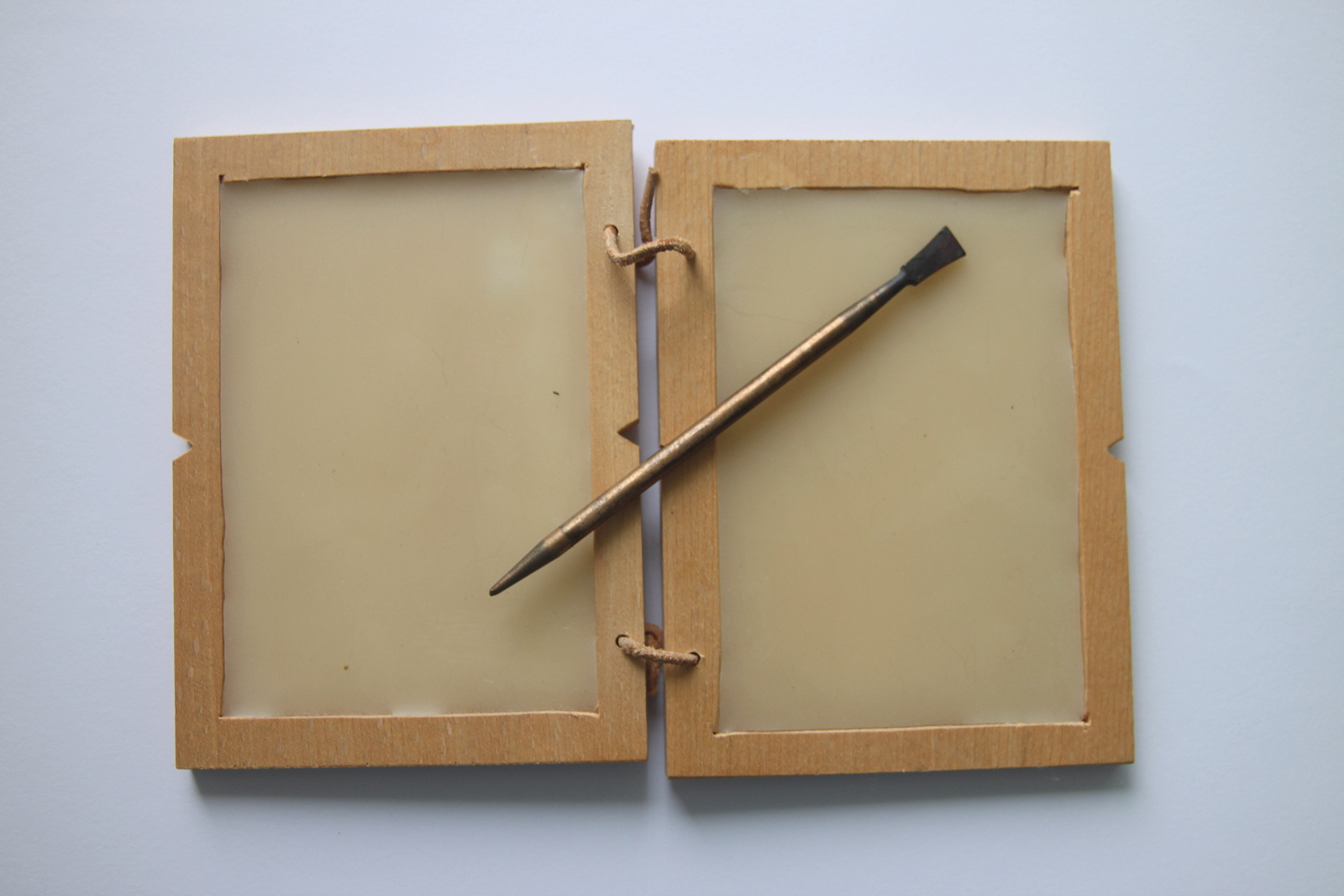|
Codex
The codex (: codices ) was the historical ancestor format of the modern book. Technically, the vast majority of modern books use the codex format of a stack of pages bound at one edge, along the side of the text. But the term ''codex'' is now reserved for older manuscript books, which mostly used sheets of vellum, parchment, or papyrus, rather than paper. By convention, the term is also used for any Aztec codex (although the earlier examples do not actually use the codex format), Maya codices and other pre-Columbian manuscripts. Library practices have led to many European manuscripts having "codex" as part of their usual name, as with the Codex Gigas, while most do not. Modern books are divided into paperback (or softback) and those bound with stiff boards, called hardbacks. Elaborate historical bindings are called treasure bindings. At least in the Western world, the main alternative to the paged codex format for a long document was the continuous scroll, which was the ... [...More Info...] [...Related Items...] OR: [Wikipedia] [Google] [Baidu] |
Aztec Codex
Aztec codices ( , sing. ''codex'') are Mesoamerican Codices, Mesoamerican manuscripts made by the pre-Columbian Aztecs, Aztec, and their Nahuatl-speaking descendants during the New Spain, colonial period in Mexico. Most of their content is pictorial in nature and they come from the multiple Indigenous groups from before and after Spanish contact. Differences in styles indicate regional and temporal differences. The types of information in manuscripts fall into several broad categories: calendar or time, history, genealogy, cartography, economics/tributes, census and cadastral, and property plans. Codex Mendoza and the Florentine Codex are among the important and popular colonial-era codices. The Florentine Codex, for example is known for providing a Nahuatal narrative of the Spanish Conquest from the viewpoint of the Indigenous people, instead of Europeans. History Before the start of the Spanish colonization of the Americas, the Mexica and their neighbors in and around th ... [...More Info...] [...Related Items...] OR: [Wikipedia] [Google] [Baidu] |
Maya Codices
Maya codices (: ''codex'') are folding books written by the Pre-Columbian era, pre-Columbian Maya civilization in Maya script, Maya hieroglyphic script on Mesoamerican Amate, bark paper. The folding books are the products of professional scribes working under the patronage of deities such as the Tonsured Maize God and the Howler Monkey Gods. The codices have been named for the cities where they eventually settled. The ''Dresden Codex'' is generally considered the most important of the few that survive. The Maya made paper from the inner bark of a certain Ficus, wild fig tree, ''Ficus cotinifolia''. This sort of paper was generally known by the word ''huun'' in Mayan languages (the Aztec people far to the north used the word ''amatl, āmatl'' for paper). The Maya developed their ''huun''-paper around the 5th century. Maya paper was more durable and a better writing surface than papyrus. Background There were many books in existence at the time of the Spanish conquest of Yucatá ... [...More Info...] [...Related Items...] OR: [Wikipedia] [Google] [Baidu] |
Codex Gigas
The ''Codex Gigas'' ("Giant Book"; ) is the largest extant medieval illuminated manuscript in the world, at a length of . It is a Romanesque Latin Bible, with other texts, some secular, added in the second half of the book. Very large illuminated bibles were typical of Romanesque monastic book production, but even among these, the page-size of the Codex Gigas is exceptional. The manuscript is also known as the ''Devil's Bible'' due to its highly unusual full-page portrait of Satan, the Devil, and the legend surrounding the book's creation. Apart from the famous page with an image of the Devil, the book is not very heavily illustrated with figurative miniatures, compared to other grand contemporary Bibles. The manuscript was created in the early 13th century in the Benedictine monastery of Podlažice in Chrast, Bohemia, now a region in the modern-day Czech Republic. The manuscript contains the complete Latin Bible in the Vulgate version, as well as other popular works, all ... [...More Info...] [...Related Items...] OR: [Wikipedia] [Google] [Baidu] |
Bible
The Bible is a collection of religious texts that are central to Christianity and Judaism, and esteemed in other Abrahamic religions such as Islam. The Bible is an anthology (a compilation of texts of a variety of forms) originally written in Hebrew, Aramaic, and Koine Greek. The texts include instructions, stories, poetry, prophecies, and other genres. The collection of materials accepted as part of the Bible by a particular religious tradition or community is called a biblical canon. Believers generally consider it to be a product of divine inspiration, but the way they understand what that means and interpret the text varies. The religious texts were compiled by different religious communities into various official collections. The earliest contained the first five books of the Bible, called the Torah in Hebrew and the Pentateuch (meaning 'five books') in Greek. The second-oldest part was a collection of narrative histories and prophecies (the Nevi'im). The third co ... [...More Info...] [...Related Items...] OR: [Wikipedia] [Google] [Baidu] |
Bookbinding
Bookbinding is the process of building a book, usually in codex format, from an ordered stack of paper sheets with one's hands and tools, or in modern publishing, by a series of automated processes. Firstly, one binds the sheets of papers along an edge with a thick needle and strong thread. One can also use loose-leaf rings, binding posts, twin-loop spine coils, plastic spiral coils, and plastic spine combs, but they last for a shorter time. Next, one encloses the bound stack of paper in a cover. Finally, one places an attractive cover onto the boards, and features the publisher's information and artistic decorations. The trade of bookbinding includes the binding of blank books and printed books. Blank books, or stationery bindings, are books planned to be written in. These include accounting ledgers, guestbooks, logbooks, notebooks, manifold books, day books, diary, diaries, and sketchbooks. Printed books are produced through letterpress printing, offset printing, offset litho ... [...More Info...] [...Related Items...] OR: [Wikipedia] [Google] [Baidu] |
Manuscript
A manuscript (abbreviated MS for singular and MSS for plural) was, traditionally, any document written by hand or typewritten, as opposed to mechanically printed or reproduced in some indirect or automated way. More recently, the term has come to be understood to further include ''any'' written, typed, or word-processed copy of an author's work, as distinguished from the rendition as a printed version of the same. Before the arrival of prints, all documents and books were manuscripts. Manuscripts are not defined by their contents, which may combine writing with mathematical calculations, maps, music notation, explanatory figures, or illustrations. Terminology The word "manuscript" derives from the (from , hand and from , to write), and is first recorded in English in 1597. An earlier term in English that shares the meaning of a handwritten document is "hand-writ" (or "handwrit"), which is first attested around 1175 and is now rarely used. The study of the writing ( ... [...More Info...] [...Related Items...] OR: [Wikipedia] [Google] [Baidu] |
Parchment
Parchment is a writing material made from specially prepared Tanning (leather), untanned skins of animals—primarily sheep, calves and goats. It has been used as a writing medium in West Asia and Europe for more than two millennia. By AD 400 most literature in these regions that was intended for preservation began to be transferred from papyrus to parchment. ''Vellum'' is a finer-quality parchment made from the skins of young animals such as lambs and young calves. The generic term ''animal membrane'' is sometimes used by libraries and museums that wish to avoid distinguishing between parchment and vellum. Parchment and vellum Today the term ''parchment'' is often used in non-technical contexts to refer to any animal skin, particularly goat, sheep or cow, that has been scraped or dried under tension. The term originally referred only to the skin of sheep and, occasionally, goats. The equivalent material made from calfskin, which was of finer quality, was known as ''vellum'' ... [...More Info...] [...Related Items...] OR: [Wikipedia] [Google] [Baidu] |
Vellum
Vellum is prepared animal skin or membrane, typically used as writing material. It is often distinguished from parchment, either by being made from calfskin (rather than the skin of other animals), or simply by being of a higher quality. Vellum is prepared for writing and printing on single pages, scrolls, and codex, codices (books). Modern scholars and experts often prefer to use the broader term "membrane", which avoids the need to draw a distinction between vellum and parchment. It may be very hard to determine the animal species involved (let alone its age) without detailed scientific analysis. Vellum is generally smooth and durable, but there are great variations in its texture which are affected by the way it is made and the quality of the skin. The making involves the cleaning, bleaching, stretching on a frame (a "herse"), and scraping of the skin with a crescent-shaped knife (a "lunarium" or "lunellum"). To create tension, the process goes back and forth between scrapi ... [...More Info...] [...Related Items...] OR: [Wikipedia] [Google] [Baidu] |
Scroll
A scroll (from the Old French ''escroe'' or ''escroue''), also known as a roll, is a roll of papyrus, parchment, or paper containing writing. Structure A scroll is usually partitioned into pages, which are sometimes separate sheets of papyrus or parchment glued together at the edges. Scrolls may be marked divisions of a continuous roll of writing material. The scroll is usually unrolled so that one page is exposed at a time, for writing or reading, with the remaining pages rolled and stowed to the left and right of the visible page. Text is written in lines from the top to the bottom of the page. Depending on the language, the letters may be written left to right, right to left, or alternating in direction (boustrophedon). History Scrolls were the first form of editable record keeping texts, used in Eastern Mediterranean ancient Egyptian civilizations. Parchment scrolls were used by the Israelites among others before the codex or bound book with parchment pages was invented ... [...More Info...] [...Related Items...] OR: [Wikipedia] [Google] [Baidu] |
Treasure Binding
A treasure binding or jewelled bookbinding is a luxurious book cover using metalwork in gold or silver, jewels, or ivory, perhaps in addition to more usual bookbinding material for book covers such as leather, velvet, or other cloth. The actual bookbinding technique is the same as for other medieval books, with the folios, normally of vellum, stitched together and bound to wooden cover boards. The metal furnishings of the treasure binding are then fixed, normally by tacks, onto these boards. Treasure bindings appear to have existed from at least Late Antiquity, though there are no surviving examples from so early, and Early Medieval examples are very rare. They were less used by the end of the Middle Ages, but a few continued to be produced in the West even up to the present day, and many more in areas where Eastern Orthodoxy predominated. The bindings were mainly used on grand illuminated manuscripts, especially gospel books designed for the altar and use in church service ... [...More Info...] [...Related Items...] OR: [Wikipedia] [Google] [Baidu] |
Book
A book is a structured presentation of recorded information, primarily verbal and graphical, through a medium. Originally physical, electronic books and audiobooks are now existent. Physical books are objects that contain printed material, mostly of writing and images. Modern books are typically composed of many pages bound together and protected by a cover, what is known as the '' codex'' format; older formats include the scroll and the tablet. As a conceptual object, a ''book'' often refers to a written work of substantial length by one or more authors, which may also be distributed digitally as an electronic book ( ebook). These kinds of works can be broadly classified into fiction (containing invented content, often narratives) and non-fiction (containing content intended as factual truth). But a physical book may not contain a written work: for example, it may contain ''only'' drawings, engravings, photographs, sheet music, puzzles, or removable content like ... [...More Info...] [...Related Items...] OR: [Wikipedia] [Google] [Baidu] |
Wax Tablet
A wax tablet is a tablet (other), tablet made of wood and covered with a layer of wax, often linked loosely to a cover tablet, as a "double-leaved" diptych. It was used as a reusable and portable writing surface in classical antiquity, antiquity and throughout the Middle Ages. Cicero's letters make passing reference to the use of ''cerae'', and some examples of wax-tablets have been preserved in waterlogged deposits in the Roman Britain, Roman fort at Vindolanda on Hadrian's Wall. Medieval wax tablet books are on display in several European museums. Writing on the wax surface was performed with a pointed instrument, a stylus. A straight-edged spatula-like implement (often placed on the opposite end of the stylus tip) would be used as an eraser. The modern expression of ''"a clean Slate (writing), slate"'' equates to the Latin expression ''"tabula rasa"''. Wax tablets were used for a variety of purposes, from taking down students' or secretaries' notes to recording bus ... [...More Info...] [...Related Items...] OR: [Wikipedia] [Google] [Baidu] |











